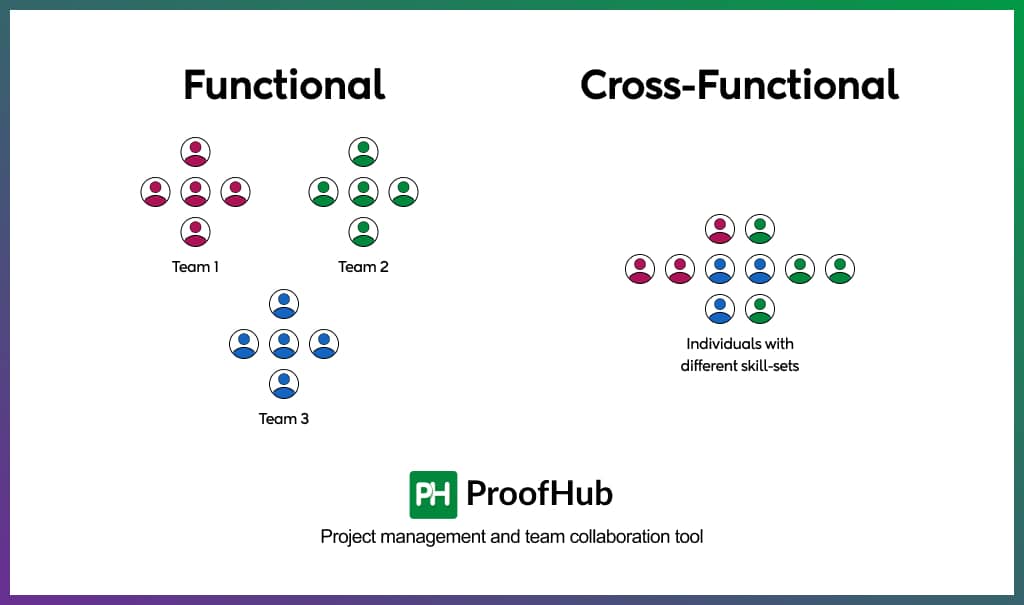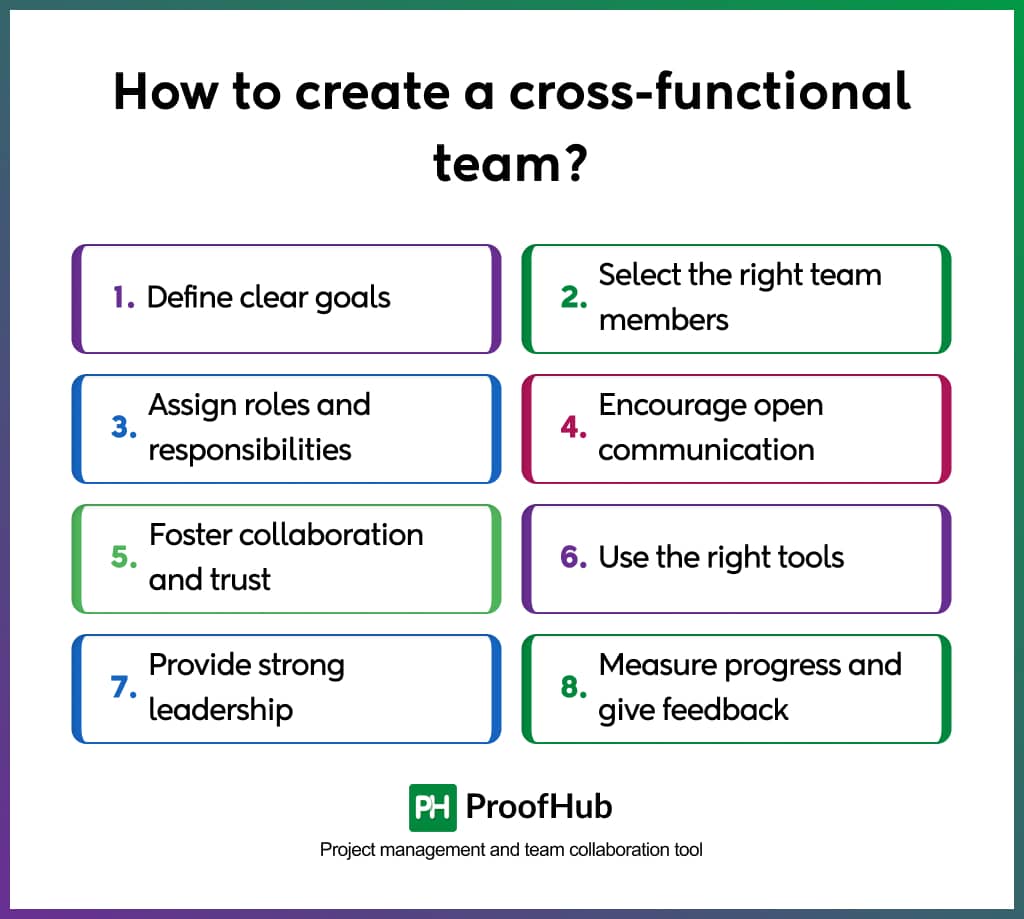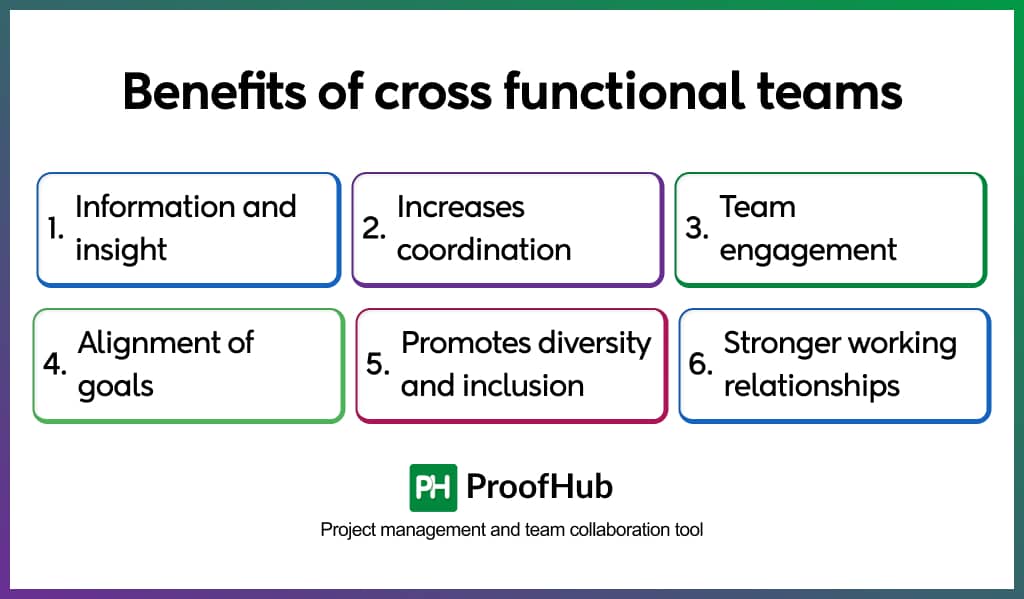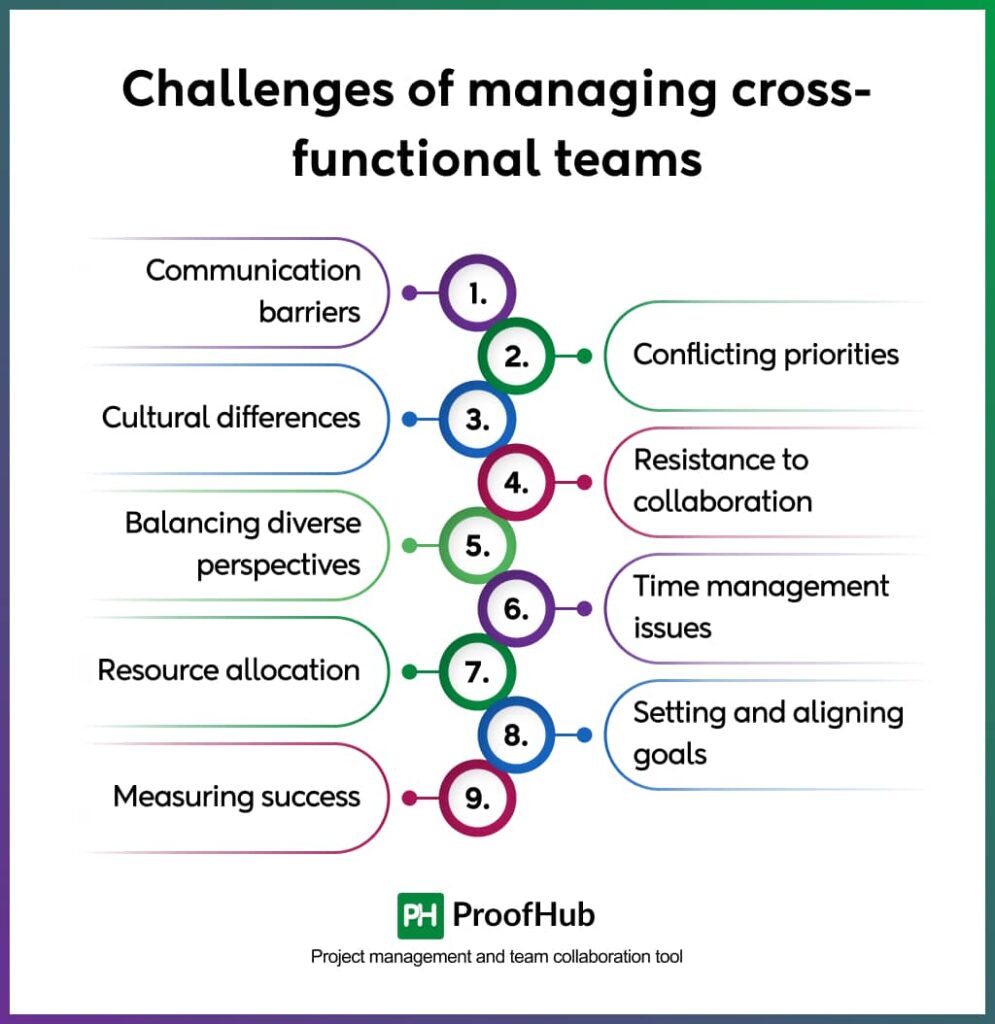Working together across departments is important for success in an organization. Many professionals with expertise are needed to execute a project to its completion successfully. Sometimes, individuals have excellent skills and prowess in their fields, yet they fail to deliver because they do not know how to work with a team.
In recent years, top-tier organizations have opted for the concept of cross-functional teams for effectively managing and completing projects. These teams bring together diverse perspectives, enhance skills, and boost productivity. They come together to solve problems, create new products, or work on important projects.
This article will explain what cross-functional teams are, what their benefits and importance are, and how ProofHub helps cross-functional teams work smoothly.
What is a cross-functional team?
Cross-Functional Team is a work-group consisting of employees from various backgrounds and areas of expertise who collaborate to work on a common project.
It includes professionals from various functional areas of an organization as well as from outside with relevant experience in their respective fields.
To impart creativity and new ideas to a project, organizations opt for cross-functional governance consisting of several functional teams and groups separated by distinctions of departments or even organizations and work towards achieving a common goal.
Even though functional boundaries and sub-teams separate members, they must collaborate and work in cohesion to ensure they achieve their goals.
Functional teams vs cross-functional teams

There are two common types of teams in a workplace – functional and cross-function teams. Here’s how they are different from each other:
Functional teams
A functional team is a group of people working in the same department and with the same expertise. For example, a marketing team has only marketing professionals who work on marketing-related tasks. These teams are specialized and focus on achieving the goals of their department.
Cross-functional teams
A cross-functional team is a group of people from different departments working on a project or a problem, such as marketing, engineering, development, and sales. The goal is to use their skills and ideas to solve complex tasks that require input from multiple areas.
Both types of teams are important for different kinds of work. However, cross-functional teams are useful for projects that require various skills and creative solutions.
How to create a cross-functional team?
Creating a cross-functional team requires proper planning and management. Here are some important steps to create a cross-functional team:

1. Define clear goals
Set clear goals for your teams. Everyone in your team should know what they are working on, whether it’s a new product launch, process improvement, or a specific task.
2. Select the right team members
Choose individuals from different departments who have the expertise and skills needed for the project. Make sure to choose individuals who are knowledgeable, good communicators, and team players.
3. Assign roles and responsibilities
Assign clear roles to each member of the team. This helps avoid confusion and ensures everyone knows what is expected. Also, a team leader should be chosen who can manage communication between departments and keep the team on track.
4. Encourage open communication
Open communication is the key to success in cross-functional teams. Create an environment where team members feel comfortable sharing ideas and addressing issues.
5. Foster collaboration and trust
Building trust in team members is very important for collaboration. Encourage respect and teamwork by creating a culture that values everyone’s input. Trust helps team members work together and make decisions quickly.
6. Use the right tools
Use project management and collaboration tools that make it easy to track progress, share information, and communicate across teams. A project management tool like ProofHub can help keep everyone connected and organized.
7. Provide strong leadership
A cross-functional team needs a strong leader to guide them and resolve any conflicts. The leader should be one who can motivate the team, guide them, and ensure smooth collaboration across departments.
8. Measure progress and give feedback
Set a performance matrix for the team to know how smoothly the team is working. Regularly review progress, celebrate success, and offer feedback so that the team stays motivated.
What are the benefits of cross functional teams?
Cross-functional teams are a great way out for teams looking to expand their horizons, deliver better results, and work in unison toward a common goal. Cross-functional collaboration has numerous benefits. Here are a few of them summarized for better understanding:

1. Information and insight
Cross-functional teams are best known for fostering creativity and change. When professionals from various areas of expertise collaborate to work on a common agenda, the probability of gaining insights about different professions and how they affect your work also increases manifold. Moreover, such employees are complementary to one another, help each other enhance their skills, and lend a fresh perspective.
Cross-functional teams are also known to multiply creativity and innovation. Hence, it generates the best possible results. Through the amalgamation of different ideas and thoughts, they lend a creative vision to the project, and that is one of the biggest benefits of a cross-functional team.
2. Increases coordination
When working with a team, the major problem one faces is the lack of coordination and cohesion among the members. This problem is easily tackled with a cross-functional team, where professionals are working individually yet together, and are well aware of what the others are doing and what is required of them.
From sales to marketing and development to testing, each vertical of the team works in harmony with the other to avoid any conflicts or confusion. Their ultimate goal is to enhance customer experience and work together to provide enterprise customers with a wholesome experience and, thus, generate the desired results.
3. Team engagement and communication
With increased collaboration and coordination comes the gift of effective communication, which is intrinsic to cross-functional teamwork. Communication is quintessential to the smooth working of any team and generating an output. Cross-functional teams are known to improve communication and facilitate the exchange of ideas in a wholesome manner.
According to Gallup’s State of the Global Workplace report, 85% of employees are not actively engaged in the workplace. These deteriorating employee engagement rates are detrimental to the productivity of an organization. Cross-functional teams are known to boost engagement by helping team members bond, exchange ideas, interact, and revamp the overall workplace dynamics.
4. Alignment of goals
Employees go astray while working on a project, which affects their performance and the performance of the organization as a whole. Cross-functional teams help keep the goals aligned with the company objectives and show the team a clear picture of what is required of them.
When working together, despite different roles, a team must move in a single direction and be aware of what the others are working towards. This is facilitated easily through cross-functional teamwork. It directly impacts productivity, as each member is cognizant of how their work affects the overall results.
5. Promotes diversity and inclusion
Another great benefit of cross-functional teams is that they promote diversity. As we know, cross-functional teams do not thrive on hierarchical structures like other teams; employees are given adequate importance based on their role in the team. Everyone’s role in a team and their skill are considered significant and greatly valued.
By diversifying a team and integrating technical and non-technical professionals, organizations not only capitalize on the best skills of their teams but also help them gain valuable insights about each other’s professions.
6. Stronger working relationships
It is extremely great to develop healthy, amiable relationships at work especially when you’re working on the same team. Cross-functional teams help foster better work relationships, helping them get a clearer understanding of what is required of them.
The basis of great productivity is a collaborative team working in complete sync with one another and building a great rapport and a sense of accountability towards their colleagues.
Why cross-functional teams are important?
Cross-functional teams have proven to be an asset for organizations hence, their widespread demand. When we think of why cross-functional teams are important, countless reasons come to mind. To paint a clearer picture of why cross-functional teams are key, a list of factors has been listed below:

1. Improved communication
Communication is the mainspring of the success of an organization, the glue that keeps it intact. According to recent collaboration statistics, only 5.9% of professionals in organizations communicate their work goals on an everyday basis.
This is where cross-functional teamwork plays a major role. When professionals with ample knowledge of their domain come together they are required to work individually yet communicate functionally to ensure the success of their project.
As per the communication statistics of 2023, almost 66% of professionals say they stopped dealing with organizations and moved to their competitors due to poor business communication skills.
This is where cross-functional communication proves beneficial. Unlike other teams, cross-functional teams communicate not just from the top down but also amongst team members at every level of the project.
Members from different verticals of a project take insights from one another on each step and work with everyone’s collective opinions.
2. Boost innovation
In today’s world, creativity and mass appeal are key to the success of a project. Experts from different areas lend their vision to the success of a common project, augmenting innovation within cross-functional teams.
Every individual brings experience and ideas to the table, and we can filter out the best ones to generate the best results.
When members with complementary skills begin working together they promote communication and collaboration while adding the much needed inventiveness to a project.
Cross-functional teams lend an assortment of perspectives to a task which boosts innovation and thus, improves overall performance.
3. Enhance productivity
When working together it is essential that members give their 100% and do not slack. Cross-functional teamwork does not progress in the regular pecking order, rather they work in customized workflows with everyone working individually yet cohesively.
Professionals working on what they know best with well-rounded inputs from others are generally more productive than traditional corporate teams. Experts believe that cross-functional collaboration brings diversity to an organization and helps keep the goals aligned.
This gives members more time to finish their work perfectly. Even though such teams are not devoid of a leader, there is room for individuals to work on their own and be productive.
4. Learning new skills
Another upside to working with various professionals in a cross-functional team is that they get ample information about each other’s fields. This helps them understand the project better at every stage and deliver accordingly.
From iterating on ideas quicker to understanding what your colleagues want out of you, cross-functional teams allow the transfer of knowledge.
For example, a marketing professional can learn about what the content team is looking for and learn about it likewise content team can work in cohesion with the development team to prepare content as per their requirements.
This gives each person an insight into what other members do and value their work as well.
How do cross functional teams work?
Multiple experts from their fields come together to successfully execute a project to its fulfillment, creating cross-functional teams. The presence of professionals from different backgrounds makes working a wonderful experience while also being able to generate great results.
Most teams work around their forte, the marketing team focuses on promoting their product, sales professionals want to boost their sales, and the accounting team keeps track of the finances. The working of a cross-functional team might not follow the hierarchy, but that in no way means it lacks organization and structure.
- The first step is assembling a group of highly trained professionals who bring with them experience and knowledge to a project and are also capable of working in a team.
- While there are no leadership structures in a cross-functional team, there is a requirement for a supervising force that can hold the team accountable and monitor the output.
- Everyone must understand the objectives and outcomes of a project clearly, as well as what they individually need to do.
- The members of a team must also comprehend what stakeholders are expecting and must stir in a similar direction. We must ensure ample representation of stakeholders in the team and consider their needs important.
- Furthermore, all teams must work in cohesion on their targets while also communicating effectively with each other at every stage.
- Members must quit relying on regular meetings and must embrace project management and collaboration software like ProofHub as mentioned above. ProofHub helps teams allocate and manage work while also helping them stay on top of deadlines.
- Members of cross functional teams must undergo conflict resolution training and learn to develop consensus to ensure effective results.
- We must place value on the skill and role of every team member rather than giving them an upper hand based solely on their experience and position.
- The Human Resource department must also involve itself in the training and development process, considering the dynamics of the team at every step.
How cross-functional teams help in collaboration?

By now, we have gained a thorough understanding of what cross-functional teams are and how they maximize productivity in an organization. If the readers put two and two together they can easily understand the functioning, but to impart clarity here is an example of a cross functional team.
A cross-functional team encompasses several sub-divisions with experts from various backgrounds.
The focus of such a team will be on the diversity of talent from multifarious fields. Professionals from the following areas of work will work in a cross-functional team:
1. Research and development
Professionals from this section brainstorm ideas related to the product’s scope and market requirements, assess customer problems, present solutions, and provide perspective to idea developers.
The R&D team evaluates product information and profitability or loss, collaborating constantly with the idea screening and concept developing team to gather input.
2. Idea screening
Successful product development depends on selecting an idea with the maximum possibility of success and potential for the future. Professionals from this department regularly communicate with research persons and gain their opinions while also using their skills.
In this stage, professionals work collaboratively with technical resource specialists, market analysts, and developers. Their opinion is greatly valued and they are consulted throughout the process of ideation.
3. Concept development & testing
Generating a concept, building a detailed version of it, and carefully employing the research done is very important. As per CBI insights, “17% of startup ideas fail just because it was a poor product.”
This highlights the importance of evaluating the proposition and screening the idea before finalizing something and creating a strategy around it.
4. Creating a market strategy
When creating a strategy around a project it is quintessential to assess the market, conduct a competitor analysis, and create a value proposition report.
This way experts from other verticals can give their feedback as well and help in successfully taking the product to the testing stage. The marketing model must cost-effectively appeal to the right audience simultaneously.
5. Assessment and development
Once all the above-mentioned stages are completed, technical experts take over. They use well-guided insights from professionals in the aforementioned fields to develop a prototype that visualizes the product.
Subsequently, they create the Minimum Viable Product (MVP). Throughout the assessment process, technical team members actively participate and receive regular updates about the product.
6. Market testing and commercialization
The final stage translates to professionals testing the product on the target market to eliminate any chances whatsoever of any kind of uncertainty and checking the overall viability of the product. There are two basic market strategies that professionals follow:
- Alpha Testing: Conducted by test engineers who judge the product based on its performance and issue the required changes after discussing with members of other verticals as well.
- Beta Testing: Here the customers and target audience test the product and give an unfiltered opinion.
Professionals from all of the aforementioned fields come together with their expertise and knowledge to develop the required product and this is a perfect example of a cross functional team.
This way, by recruiting experts from their respective fields and integrating them to work together harmoniously, organizations can accomplish many tasks and profit considerably.
What are the challenges of managing cross-functional teams?
Managing cross-functional teams comes with its own set of challenges. Here are some of the key difficulties leaders may face:

- Communication barriers: Different departments may use different terms and communication styles. This can lead to misunderstandings.
- Conflicting priorities: Team members may prioritize their regular departmental tasks over the team’s goals, leading to conflicting priorities.
- Cultural and departmental differences: Each department may have its own work culture and approaches, leading to clashes in teamwork.
- Resistance to collaboration: Some team members may hesitate to work together because they do not trust each other or they had negative experiences in the past.
- Balancing diverse perspectives: Diverse viewpoints can enhance creativity, but sometimes, they can also lead to conflicts or indecision if they are not managed well.
- Time management issues: Scheduling meetings and working together can be challenging because people from different departments have their commitments.
- Resource allocation: Securing necessary resources like time and budget can be difficult when competing with other departmental needs.
- Setting and aligning goals: Getting all team members to understand and agree on the same goals can be tough when different departments have their own goals.
- Measuring success: In cross-functional teams, defining a success matrix can be very complex, as different departments have different performance indicators.
How ProofHub help cross-functional teams work smoothly?
As per research, online collaboration tools and digitization at the workplace increase productivity by up to 30%. Modern workforce requirements make it inevitable to work with multi-management online tools that make collaboration easier especially for cross-functional teams. There are various tools in the market for cross functional collaboration, and ProofHub is one of the best you can utilize.
ProofHub is a one-stop shop for effective management and communication in a multi-tiered team. It simplifies working together and helps achieve goals well in time.
When it comes to online management tools, it is a top choice among high-ranking professionals looking to expand their horizons and maximize productivity. With tonnes of features, ProofHub is extremely comfortable to use, especially for cross functional teams where collaboration, communication, and management are key.
Even in a structure as dynamic and organized as a cross functional team ensuring cohesion and effective teamwork can be a challenge, but ProofHub simplifies it.
From personalized individual and group chat options to time tracking and custom workflows, ProofHub offers it all. It is indispensable for cross functional teamwork as it allows professionals from multiple disciplines to band together and work towards common goals. The following features make ProofHub ideal for cross-functional governance:
- Custom roles
- Custom workflows and kanban boards
- Tasks with deadlines
- Group chat
- Dedicated space for discussions
- Online proofing tool
- File sharing
- Integrations with third-party apps
- Flat pricing
All these features make ProofHub imperative for cross-functional parties across the globe and this is precisely why as the trend of cross-functional collaboration grows so does the popularity of the tool.
Conclusion
Cross-functional teams are becoming increasingly popular, especially during the present times when major corporations are relying heavily on remote work. Such teams allow organizations to recruit professionals based on their skills and expertise and enable them to deliver to the best of their abilities.
Professionals also experience a positive psychological impact from cross-functional teams, enabling them to deliver their best.
With plenty of room to grow, learn, and explore, cross-functional teamwork ensures that professionals work in unison to generate desired results rather than passing work from one silo to another. It focuses on both the organization and individuals, giving equal weightage to everyone’s skills.
A wholesome working environment in a cross-functional team positively boosts employees, leading to successful project execution.
In a nutshell, we can refer to cross-functional teams as the future of proactive collaboration and corporate teamwork.
I hope this information is helpful to you and gives you abundant information about the concept and importance of cross-functional collaboration.

